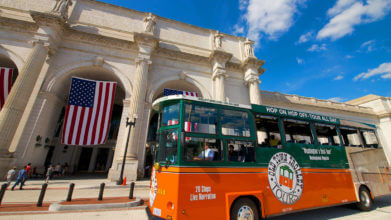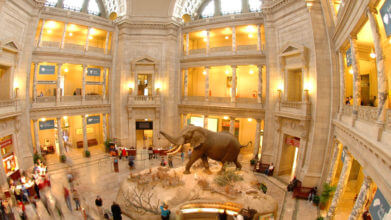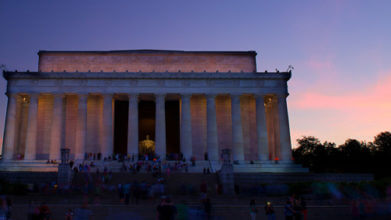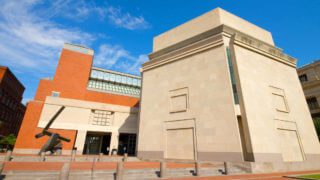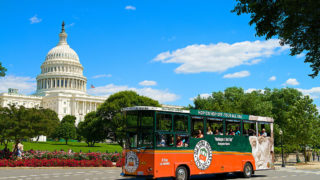Lincoln Memorial – Transfer for Arlington National Cemetery Shuttle
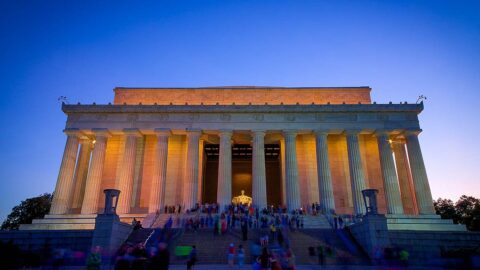
The Lincoln Memorial was opened on Memorial Day in 1922, 57 years after Abraham Lincoln, the 16th President of the United States, was assassinated. The immense Greek Temple stands in front of a gleaming reflecting pool and is a stunning spectacle during the day and especially at night.
This is also the trolley stop where you transfer to the shuttle that takes you to Arlington National Cemetery. The first Arlington shuttle departs the Lincoln Memorial at 9:30 am. The last shuttle from the Lincoln Memorial to Arlington National Cemetery is at 3:30 pm. The last shuttle from Arlington National Cemetery to the Lincoln Memorial is at 3:45 pm.
A Visitor’s Guide to the Lincoln Memorial
The Lincoln Memorial stands as a symbol of unity, strength and dedication, honoring one of America’s most revered presidents, Abraham Lincoln. Situated at the western end of the National Mall in Washington, DC, this iconic structure has become a must-visit destination for history buffs, tourists, and anyone interested in the story of the United States. The memorial offers an unforgettable experience for anyone exploring the nation’s capital. Whether you are here to reflect on Lincoln’s legacy, take in the architectural splendor or simply enjoy the peaceful surroundings, the Lincoln Memorial promises a visit rich in history and inspiration.
History of the Lincoln Memorial
The journey to create a national memorial for Abraham Lincoln began long before its opening on Memorial Day in 1922. In fact, the idea of a dedicated monument to the 16th president dates back to shortly after his assassination in 1865, when the nation mourned the loss of a leader who had preserved the Union and abolished slavery. The first public statue of Lincoln, designed by Lot Flannery, was erected outside the District of Columbia City Hall in 1868, but the desire for a grander tribute lingered, reflecting the deep respect and admiration that Americans held for Lincoln’s contributions to the country. Early efforts to establish a memorial faced challenges, including insufficient fundraising and design disagreements. It wasn’t until 1910, with the leadership of Senator Shelby M. Cullom of Illinois and the support of President William H. Taft, that a formal commission was established to oversee the creation of a monument befitting Lincoln’s legacy.
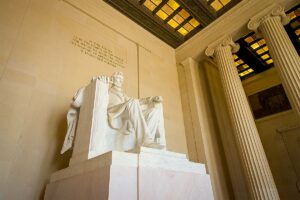
The location on the National Mall, positioned to overlook the Reflecting Pool, was chosen to emphasize the memorial’s importance and to create a direct visual connection to the Washington Monument and the U.S. Capitol. Inside, the 19-foot marble statue of Lincoln, sculpted by Daniel Chester French, sits with a contemplative expression, embodying the spirit of a leader who guided the nation through the Civil War and helped to preserve the Union. The inscriptions of the “Gettysburg Address” and Lincoln’s “Second Inaugural Address” on the walls remind visitors of his words that shaped American history, inviting reflection on the enduring values of liberty and justice.
Interesting Facts About the Lincoln Memorial
- The Lincoln Memorial opened nearly 60 years after Lincoln’s assassination, following decades of planning and debate. It stands today as a testament to the enduring impact of his leadership and vision for a united nation.
- Architect John Russell Pope, who later designed the Jefferson Memorial, initially proposed bold designs for the Lincoln Memorial, including a Mayan temple and an Egyptian pyramid. However, Henry Bacon’s classical Greek design was ultimately chosen, emphasizing the democratic ideals that Lincoln championed.
- One of the lesser-known facts about the Lincoln Memorial is that the memorial’s walls and columns are slightly tilted inward, a design choice intended to correct optical illusions and ensure the structure appears perfectly straight when viewed from a distance.
- In September 1942, during World War II, a mishap occurred when an anti-aircraft gun crew accidentally fired rounds, striking the façade of the memorial. Although no one was injured, a scar from the incident remains visible on the marble, serving as a reminder of the challenges faced during wartime.
- The steps leading from the Reflecting Pool to the Lincoln Memorial number exactly 87 — a symbolic nod to the famous phrase “four score and seven years ago” from Lincoln’s “Gettysburg Address.” While the number of steps wasn’t deliberately planned, it has become a cherished detail that adds to the memorial’s historical resonance.
Know Before You Go
- Location and Accessibility: The Lincoln Memorial is situated at the western end of the National Mall, making it an ideal starting or ending point for a walking tour of Washington, DC’s most iconic monuments. It is easily accessible via public transportation, with nearby Metro stations like Smithsonian and Foggy Bottom. Visitors can also take advantage of the Old Town Trolley for a convenient narrated journey through the city’s historic landmarks. The trolley stops near the Lincoln Memorial, allowing you to explore at your own pace while learning about the rich history of the area.
- Visiting Hours: The Lincoln Memorial is open 24 hours a day, seven days a week, allowing visitors to experience its beauty both in daylight and when illuminated at night. While the memorial itself is always accessible, the nearby visitor center operates with specific hours, typically from 9:30 am to 10:00 pm. Plan your visit accordingly if you wish to access exhibits, restrooms, and educational materials.
- What To Bring: If you’re visiting during warmer months, bring water and sunscreen, as shade is limited around the National Mall. Comfortable walking shoes are essential, as exploring the nearby Reflecting Pool, World War II Memorial and other attractions may involve a fair amount of walking. A camera is a must for capturing the stunning views, especially during sunrise or sunset when the light casts a magical glow over the marble façade.
- Tips for Families: The Lincoln Memorial is family-friendly and provides an excellent opportunity for children to learn about American history. Interactive exhibits at the visitor center can engage young minds, and the open space around the Reflecting Pool allows kids to stretch their legs and enjoy the outdoors.
Things To Do at the Lincoln Memorial
- Admire the Lincoln Statue: The 19-foot-tall statue of President Lincoln inside the memorial is a powerful sight. Crafted from 28 blocks of Georgia marble, the statue portrays Lincoln with a solemn and contemplative expression. Standing before this grand sculpture, visitors are often moved by the sense of history and reverence that fills the space.
- Explore the Columns: Take time to appreciate the 36 columns that surround the memorial, each representing a state in the Union when Lincoln died. These towering columns add to the grandeur of the structure, and the inscriptions at the top of each column honor the states’ contributions to preserving the Union.
- Reflect at the Pool: The Reflecting Pool stretches from the Lincoln Memorial to the Washington Monument, offering a tranquil space for contemplation. The water mirrors the surrounding monuments, creating beautiful reflections that enhance the experience of visiting this historic area.
- Capture Iconic Views: From the steps of the Lincoln Memorial, visitors can enjoy breathtaking views of the National Mall, including the Washington Monument and the U.S. Capitol. The vantage point is especially popular for sunrise or sunset photography, providing a stunning backdrop for capturing memorable moments.
- Join a Guided Tour: Consider joining a guided tour provided by Old Town Trolley. Knowledgeable guides share fascinating stories about Lincoln’s life, the construction of the memorial and the significant events that have taken place here, offering deeper insights into this iconic landmark.
- Discover Lincoln’s Speeches: Inside the memorial, visitors can read the words of the “Gettysburg Address” and Lincoln’s “Second Inaugural Address,” which are inscribed on the walls. These speeches offer a window into Lincoln’s vision for the nation and the values that he fought to uphold during his presidency.
- Explore Interactive Exhibits: The visitor center near the Lincoln Memorial offers educational displays and multimedia presentations that delve into the history of the monument and Lincoln’s legacy. It’s a great way to learn more about the context surrounding this important chapter in American history.
Nearby Things To Do
- Arlington National Cemetery: Just a short shuttle ride away, Arlington National Cemetery is a poignant destination where visitors can pay their respects to the nation’s military heroes. The Old Town Trolley offers a convenient shuttle transfer from the Lincoln Memorial, making it easy to explore both sites in one day.
- Vietnam Veterans Memorial: Located a short walk from the Lincoln Memorial, the Vietnam Veterans Memorial honors those who served in the Vietnam War. The names of over 58,000 service members lost during the war are etched into the black granite wall, creating a moving tribute.
- Korean War Veterans Memorial: This memorial commemorates the soldiers who fought during the Korean War, with 19 stainless steel statues representing a squad on patrol. The reflective wall alongside the statues lists the names of those who served, offering a solemn reminder of the sacrifices made.
- World War II Memorial: Situated between the Lincoln Memorial and the Washington Monument, the World War II Memorial honors the spirit and sacrifices of those who served during the war. Its design includes 56 pillars and two triumphal arches, symbolizing unity among the states and territories.
- Washington Monument: The towering Washington Monument stands as a tribute to the nation’s first president. Visitors can take an elevator ride to the top for panoramic views of Washington, DC.
FAQs
What is special about the Lincoln Memorial?
The Lincoln Memorial is a symbol of unity, democracy and the enduring legacy of President Abraham Lincoln. It is known for its grand architecture, historical significance and role as a gathering place for important events, such as Martin Luther King Jr.’s “I Have a Dream” speech during the 1963 March on Washington.
Can I visit the Jefferson and Lincoln Memorials in one day?
Yes, visiting both the Lincoln and Jefferson Memorials is possible in a single day. They are located within the National Mall, about 1.5 miles apart. The Old Town Trolley offers a convenient way to travel between them, allowing you to explore both landmarks at your own pace.
Why are there 87 steps at the Lincoln Memorial?
The 87 steps leading from the Reflecting Pool to the Lincoln Memorial’s interior chamber symbolize the phrase “Four score and seven years ago” from Lincoln’s “Gettysburg Address.” Though the number wasn’t intentionally planned, it has become a meaningful detail that resonates with visitors.
Is the Lincoln Memorial good for family visits?
Absolutely! The Lincoln Memorial is a family-friendly destination that offers educational opportunities for visitors of all ages. Children can learn about American history, explore beautiful architecture and enjoy the open space around the Reflecting Pool.
How long should we plan to spend at the Lincoln Memorial?
Most visitors spend about 45 minutes to an hour exploring the Lincoln Memorial, reading the inscriptions, and taking in the views of the National Mall. If you plan to join a guided tour or visit nearby attractions, consider allocating additional time to fully appreciate the experience.

